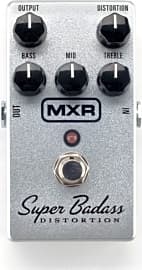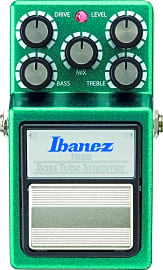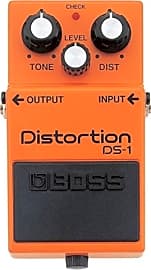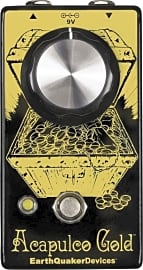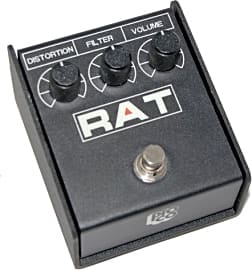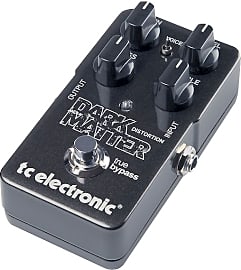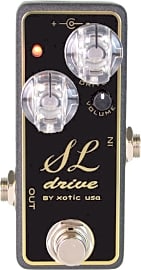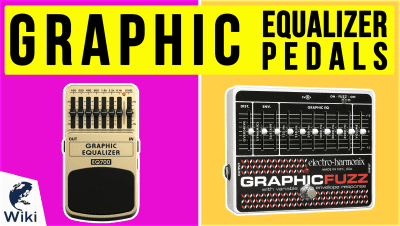The 10 Best Distortion Pedals

This wiki has been updated 39 times since it was first published in October of 2015. Anyone who wants to crank their amp up to 11 can do it with an electric guitar and a little -- or a lot of -- distortion. Whether you're aiming to shock and awe with punk or metal sounds, get the crowd dancing with some '60s garage tunes, or even add some buzz to classic blues or folk songs, this list recommends pedals to suit a range of genres, rig set-ups, and budgets. When users buy our independently chosen editorial selections, we may earn commissions to help fund the Wiki.
Editor's Notes
May 07, 2020:
Removed the Behringer Overdrive OD300 and the Joyo Crunch in favor of the Fender Pugilist and the Earthquaker Acapulco Gold V2.
Like most guitar pedals, distortion pedals modify the signal produced by your guitar before it gets to the amplifier. While distortion is most often associated with metal and hardrock, the category also includes pedals with a focus on overdrive or fuzz. These distinctions partially overlap each other but lend themselves to different musical approaches. Overdrive, like that provided by the Maxon Reissue Series OD808 Overdrive, lends itself to funk, prog-rock, and similar genres since they want to preserve the guitar's character without excessive muddling. The Ibanez TS9B is common among the likes of guitarists like Brent Hinds and John Petrucci. Like the name suggests, it works best with tube amps but I've found that I can still get a great tone out of a solid-state amp - particularly when I need a sludgier tone. It also chains very well with equalizers and delays and will easily stack with another distortion pedal.
Sending Signals To The Chopping Block
Now, this kind of experiment is meant to establish a concept more than recreate an effect, but it should start to illustrate for you the way these pedals work.
It's hard to imagine what Jimi Hendrix might have sounded like without a lick of distortion, and the same can be said for so many artists of the 60s through to today. Distortion touched a chord with an entire generation of music lovers whose anger toward their parents, toward their institutions, toward their governments found its unique and blaring voice through the harmonic complexity and outright assault of the distorted guitar.
The irony is that signal distortion is a kind of compression, a way to manipulate the signal of a given instrument so that it's got less room to flow. The very sound that set a generation free did so by confining the sound itself.
Beyond that irony lies something unexpected and altogether beautiful, though. You see, distortion takes a waveform (think of it like a steady, curved heartbeat) and adds a floor and a ceiling to it, as well as a parallel signal meant to stimulate a change in the waveform itself. The result is a phenomenon called clipping, which reduces the output at the higher and lower frequencies with different intensities depending on the device, all while changing the timbre of the original signal, creating unexpected harmonic overtones not present in the unaffected sound.
Stand across from a friend and sing a note at him. Then, have him sing the same note at you. Then, each of you sing that same note through an almost-closed fist. The parallel frequency he creates is the same, but its timbre is slightly different than yours, and the compression applied by your fists only increases the alteration in sound.
Now, this kind of experiment is meant to establish a concept more than recreate an effect, but it should start to illustrate for you the way these pedals work. In direct adjustment to the clipping of higher and lower frequencies, pedal companies will utilize internal EQ profiles to reinforce these lost tones, sometimes overemphasizing them to create a signature sound specific to a certain style of music.
Three Kinds Of Distortion
Distortion is an umbrella term. In the context of distortion pedals, it covers any kind of signal compression intended to create a dirtier sounding signal. That umbrella covers three primary kinds of distortion, and understanding how each of these alters the signal of your guitar will lead you in the right direction.
Very small amounts of clipping with a generous amount of space for the signal to breathe before distorting is an effect commonly referred to as overdrive.
The clipping we spoke of above comes in all shapes and intensities. Very small amounts of clipping with a generous amount of space for the signal to breathe before distorting is an effect commonly referred to as overdrive. What's great about this effect is that the harder you play, the stronger your input signal, the greater the distortion effect. This is the preferred effect of guitarists trying to recreate the natural overdrive found in expensive tube amps, and its increased dynamic range preserves much more of the original instrument's sound.
If you limit the waveform to a greater degree, and increase the number of parallel tones that force the signal to bend, you reach the distortion sound. These pedals are usually preferred among harder rockers, metal bands, and shredders of all ilks. Without additional EQ, the sound is almost all in the mid-range, but most distortion pedals have significant boosts to their high and low ends, allowing the pinched harmonics and doom-inducing bass tones to prevail in darker music.
The other form of distortion available under the umbrella is fuzz. Fuzz is a lot closer to the sounds produced by Hendrix, The Kinks, and The Rolling Stones as distortion pedal technology was under development. Technically, The Kinks more famously achieved the distortion effect on You Really Got Me by slashing apart their speaker cones with razor blades, but the effect was similar.
Unlike overdrive, which seeks to maintain most of the original instrument's unique sound, or distortion, which takes you one step further away from your guitar's timbre, fuzz almost obliterates the original signal, creating a sound that could be coming from any number of instruments, identifiable only by the specific notes being played. Fortunately, modern fuzz boxes have pretty elaborate internal EQs, so your sound isn't just a wall of noise.
Distortion Used To Be Tubular
Early tube amps provided the first recognizable distortion outside of an amplifier being destroyed by an instrumentalist. As the preamp tubes warmed up, the signals moving through them encountered the same kind of soft clipping you find in overdrive pedals, but with a tremendous amount of the guitar's original timbre preserved. Some artists in the 50s intentionally pushed this sound as far as they could into a more distorted realm.
Distortion beyond what anyone could have imagined exploded onto the scene in the late 70s, as punk rock took over the clubs of London and New York.
In the early 60s, Grady Martin released a few hit singles bolstered by the unique sound that came out of his amplifier's broken preamp, and other bands sought to recreate the sound however they could. Eventually, Gibson released a fuzz box called the Maestro FZ-1, which became the go-to distortion device for the likes of Keith Richards.
Distortion beyond what anyone could have imagined exploded onto the scene in the late 70s, as punk rock took over the clubs of London and New York. It took about 12 years for the early 90s and grunge to introduce a palatable distortion to the masses, unless you count the epic, obsessively compressed distortion sounds of 80s hair metal, which is an era of American music that I'd really like to forget.



